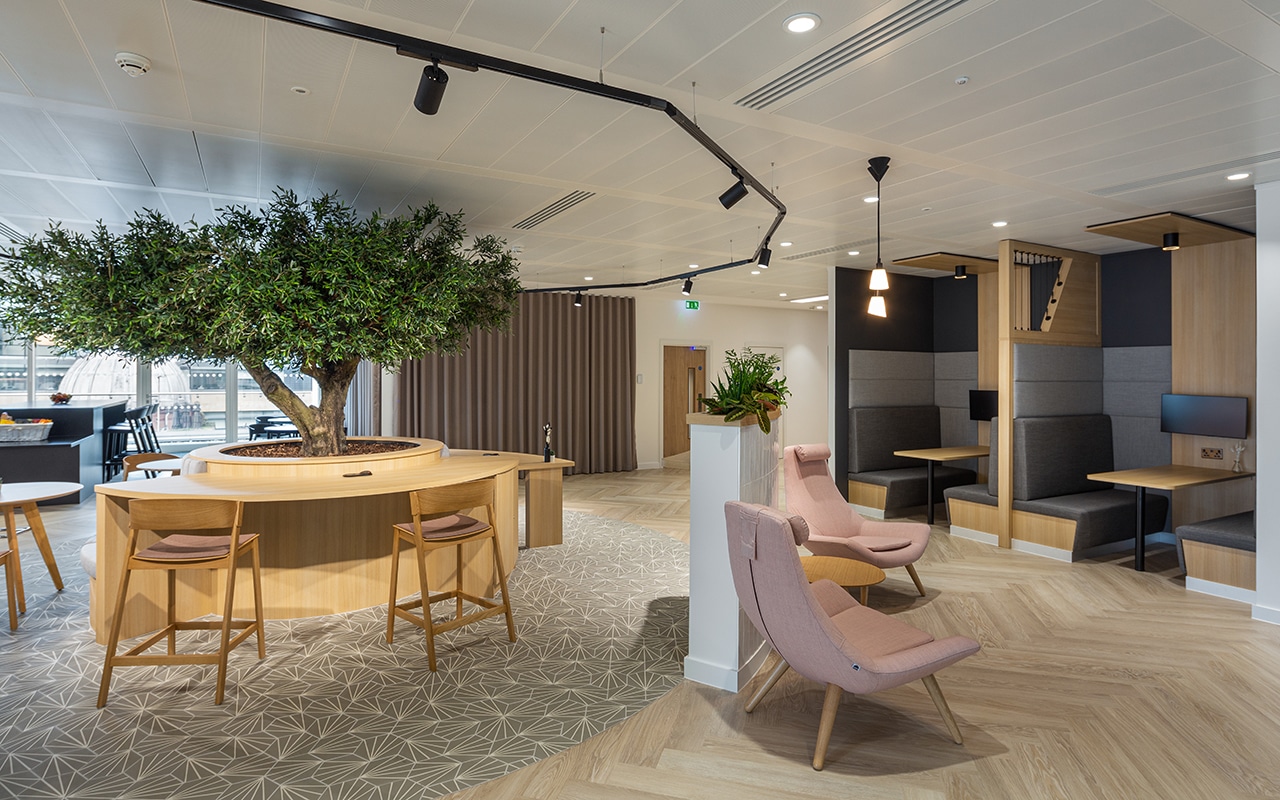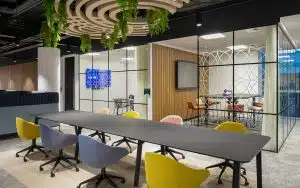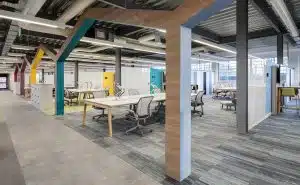When you consider that we spend more than half of our waking hours at work, the office is arguably the most important indoor environment outside of our homes. We dedicate a lot of time and attention to ensuring our homes are aesthetically appealing and comfortable, however, it’s not often that workplace design is thought about with the same importance.
The way people feel when they’re at work is influenced by the office environment and amenities, and this has been proven to impact their general health and wellbeing. As such, businesses are increasingly recognising the need to design and build office spaces which help employees feel content and comfortable at work in order to promote health and wellness.
Not only do employers have a responsibility of care to employees, but workplace design for wellbeing can also deliver wider business benefits, including higher levels of productivity, and increased performance and profit.
What is workplace design for wellbeing?
Traditional or legacy office designs are not typically conducive to supporting employee health and wellbeing. Today, businesses need to use evidence-based design to ensure their workplaces are fit for employees as well as intended purpose. Office design for employee wellbeing is about considering the relationship between the working environment and how it impacts employee wellness and behaviour. By truly understanding workplace requirements, businesses can strategically design and build a space that actively benefits employees’ mental, physical and emotional wellbeing.
Why is designing workplaces for employee wellbeing so important?
It’s no longer enough to simply provide employees with a basic desk set up if you want to get the best from them. Workplace design for wellbeing not only fulfils a vital duty of care for employees, but it also brings a multitude of business benefits:
- People are a business’ greatest asset. Investing in their physical and mental health in the workplace is important to the continuity, stability, and future of a business.
- A happy, healthy and motivated workforce is key to success. Research shows a direct link between employee wellbeing and productivity, performance, and profitability.
- Looking after employees’ physical and mental wellbeing is key to reducing illness, poor mental health, work-related stress, and absenteeism.
- A comfortable office with state-of-the-art facilities and a positive company culture is key in attracting employees back to the office in the post-pandemic world of remote and hybrid working. Give them a reason to make the commute.
- Office wellbeing is a key factor in employee satisfaction and retention. Anything businesses can do to minimise attrition and keep good talent will be an important time and cost saver in the long run.
- Good workplace design is also a valuable recruitment aid. People want to work in pleasant, comfortable and inspiring environments, and for employers that invest in and value their health and wellbeing.
- Our research shows wellbeing in the workplace is especially crucial to graduates – the future of our workforce – making it a key investment now and into the future.
How do today’s workplace designs stack up when it comes to employee wellbeing?
While we’re seeing an increasing focus on workplace design for wellbeing, and greater awareness around its importance, our research suggests that there is room for improvement in current design practices. In fact, 93% of UK office workers we spoke with agreed that their physical and mental health and wellbeing is important to them at work. Yet, only 8% would rate their workplace as excellent when asked if it is supportive of their mental and physical health and wellbeing, while 1 in 10 workers say their organisation does not currently offer anything to support them in this area.
What are the main workplace design considerations for employee wellbeing?
Many workplace design features have the ability to impact employee health and wellbeing. In particular, businesses should think about the following:
- Comfort
- Agile working
- Lighting
- Air quality
- Temperature
- Acoustics
- Access to nature
- Colours
Comfort
Our research of UK office workers identified comfort as the third most important factor to them at work, yet just 6% said they’d rate their workplace as excellent in this regard. While there are considerations around different working environments (more on that next) getting the basics right is crucial.
Employers should provide employees with ergonomically designed furniture to help prevent poor posture and health issues. Office chairs should have an adjustable seat, arm, and back rests, as well as a swivel function to boost comfort and efficiency. Users should be able to adjust their computer monitors to allow them to alter their position throughout the day. Businesses should also consider desks that can accommodate both sitting and standing positions as per user preference and to encourage movement during working hours.
Agile working
While the Covid-19 pandemic showed many employees that they could do their role from home, the office remains important in helping colleagues connect, socialise, collaborate, and feel part of the company culture. It’s crucial that businesses recognise this shift in workplace purpose and provide adequate space and opportunity for these activities.
Our research showed that 32% of workers would be more likely to come into the office if there was more choice of workplace settings. And while 35% agreed that agile working supports their wellbeing, just 1 in 3 say their company offers agile working options.
Evidently, businesses stand to gain a lot from incorporating a range of agile settings so employees can adapt how or where they work according to the task they’re working on. Many workplaces are adopting a greater range of settings, including open plan booths, sound-proofed quiet pods, collaborative and creative areas, and dedicated wellness rooms. The latter are becoming increasingly popular and are best set away from busier communal areas to enable reflection and relaxation away from the pressures of the job.
Lighting
Natural light delivers a range of health and wellbeing benefits; enhancing alertness, reducing stress, helping to regulate moods and behaviour, and improving sleep quality. In the workplace, it plays an important role in helping employees remain engaged and motivated. With this in mind, it goes without saying that businesses can benefit from incorporating as much natural light into their workplace designs as possible.
However, as we know all too well, daylight hours are limited during the winter months in the UK, and additional lighting solutions will almost certainly be needed to supplement natural light. The different spaces being catered for will have varying requirements. For example, while working areas should be bright and well-lit to aid focus, any breakout spaces or wellness rooms will benefit from ambient lighting to enhance comfort and calm.
Air quality
Access to clean, fresh air is crucial to employee health and wellbeing. Opening windows is an easy and natural way to help air circulate, however doing so in workplaces located in urban areas or near busy roads can make employees susceptible to noise and air pollution. Businesses may need to consider alternative ventilation solutions or seek advice from a design and build partner with mechanical and electrical expertise.
Temperature
Striking the right balance with temperature can be difficult as comfort levels differ depending on personal preference, but it is still an important consideration. Not only can temperature extremes cause discomfort and distraction, but Workplace Health Safety Executive Regulations state that workplaces like offices should be at least 16°C.
Businesses should consider installing controllable zonal heating and cooling systems to help create comfortable working conditions. Thermostats and sensors located throughout the building can help to monitor and regulate temperature while ensuring comfort and compliance with regulations.
Acoustics
Excessive noise levels in areas where employees are trying to concentrate can cause discomfort, irritation, headaches and stress. Set hubs for collaboration and socialising away from focus areas, and consider acoustic panels, tiles, and flooring to help to limit sound transmission and reduce external noise, along with other sound-absorbing materials and furniture. Larger spaces with high ceilings can especially benefit from the application of acoustic panelling to help minimise reverberation.
Access to nature
Connecting with nature actively improves mental health and wellbeing, and can result in improved mood, creativity and focus. Where possible, businesses should provide access to outdoor areas, such as quiet gardens or areas to eat and relax with greenery and comfortable seating. Encouraging employees to take breaks away from their desks and engage in movement and physical activities by offering these types of spaces will break up long sedentary periods.
Where space doesn’t allow for dedicated outdoor areas, companies should consider introducing biophilic design features, such as living canvases and water features, to bring the outdoors and its associated benefits into the workplace.
Colours
Colours can have a significant impact on employee emotions and behaviours. While designing in line with the brand colour palette can be a nice touch, it may not be conducive with the desired working environment. For example, the overuse of red can evoke feelings of urgency and frustration, while blue is typically associated with productivity and focus. Choices need to be considered carefully.
What will the future of workplace wellbeing design look like?
Evolving technology, inclusivity and human-centred design will continue to shape the future of workplace design for employee wellbeing. Possible trends we could see include:
- Flexible office space and collaborative hubs growing in importance as businesses accommodate the shift in workplace purpose driven by hybrid and remote work.
- A greater range of on-site amenities to promote wellbeing, such as on-site fitness centres and meditation studios. Some organisations are also experimenting with virtual reality to provide relaxation experiences.
- Catering for personal preference, allowing employees to tailor their immediate lighting and temperature settings to boost comfort.
- The rise of smart offices and data-driven workplaces to give employers a better understanding of user behaviour and how the environment impacts work practices and processes. AI can analyse data and identify patterns to aid continual learning and optimisation.
Final thought
The need to design, build and optimise workplaces for employee wellbeing is only going to become more important. In addition to providing a duty of care to employees, investing in workplace wellbeing design has been proven to deliver numerous tangible business benefits that fast-moving and competitive organisations can’t afford to ignore.
Want to learn more? For any queries relating to workplace design for employee wellbeing, or to speak with our team of expert consultants, simply get in touch.




